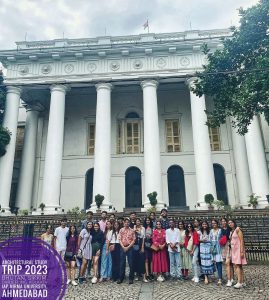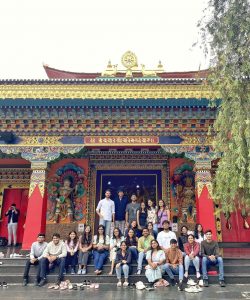REPORT – Related Study Programme -2023
| RSP – BHUTAN, SIKKIM, DARJEELING, AND KOLKATA | ||
| 1 | Name of the Course | Related Study Programme |
| 2 | RSP type | Exploratory |
| 3 | Location | Bhutan , Sikkim , Darjeeling And Kolkata |
| 4 | Date | 11-6-2023 to 29-6-2023 |
| 5 | No of students | 23 (Girls – 15, Boys – 8) |
| 6 | Faculty in coordinator | Prof. Jaishree Mishra , Prof. Biswanath Mudi |
Introduction:
Architectural study trips to Bhutan, Sikkim, Darjeeling, and Kolkata were undertaken to gain comprehensive awareness of the cities’-built environment, explore various aspects of social, educational, and settlement patterns, understand typologies, design styles, and material-construction systems prevalent in these regions, and document the social, cultural, and environmental aspects of each city. This report aims to provide a summary of the key learnings and knowledge gained during these enlightening journeys.
During this remarkable journey, our students delved into a world of rich cultural heritage, breath-taking landscapes, and architectural wonders. With a comprehensive focus on awareness and exploration, we immersed ourselves in the vibrant tapestry of these captivating cities. Here’s a glimpse into what we experienced and the invaluable knowledge gained along the way.
Comprehensive Awareness of the Cities:
Through immersive interactions and guided tours, we developed a profound understanding of the distinct identities of Bhutan, Sikkim, Darjeeling, and Kolkata. From the peaceful monasteries of Bhutan to the bustling streets of Kolkata, we observed the unique architectural expressions and urban dynamics that shape each city’s character.
Exploring the Built Environment:
We marvelled at the architectural wonders that dot these regions, studying their design principles and spatial arrangements. From ancient fortresses to contemporary sustainable structures, we explored the diverse range of architectural styles, functions, and construction techniques that make each building a masterpiece in its own right.
Understanding Typology, Design Style, and Material-Construction System:
Our study trip provided a deep dive into the world of architectural typology, where we analyzed the intricacies of different building types and their functions. By examining the design styles and material-construction systems employed, we gained a holistic understanding of how these factors contribute to the overall aesthetic and functionality of a structure.
Social, Cultural, and Environmental Aspects:
Architecture isn’t just about buildings; it’s about people, culture, and the environment. Engaging with local communities allowed us to discover how architecture shapes social interactions, preserves cultural heritage, and promotes sustainability. By balancing human needs with ecological considerations, we were inspired by the harmonious integration of traditional methods and modern approaches.
Key Learnings and Knowledge Gained by Students:
Our journey was filled with countless eye-opening moments and transformative experiences. The students not only honed their architectural skills but also developed a broader perspective on the world. They learned to appreciate the significance of context, culture, and climate in architectural design. They witnessed the power of architecture to create meaningful spaces that positively impact communities and the environment. Most importantly, they discovered their own potential to contribute to the future of sustainable and inclusive design.
This study trip has ignited a fire within our students, encouraging them to pursue excellence in their architectural endeavours.
Interactive Sessions on PARO International Airport Design, by Ar. Soumyodeep Das and Ar. Ayan Roy, Founding Partner & MD of VBRIDGE.
The short interactive sessions on PARO International Airport design with Ar. Soumyodeep Das and Ar. Ayan Roy, Founding Partner & MD of VBRIDGE, focused on architecture, design, concept, and sustainability on 24/6/2023. The discussions emphasized the importance of contextual design, integrating Bhutanese influences, and incorporating nature-inspired elements. The architects also highlighted the significance of energy efficiency, water management, and responsible material selection for sustainable airport design. By considering these factors, the design of PARO International Airport can create a harmonious environment that reflects the local culture, provides a seamless passenger experience, and minimizes its ecological impact.
Short Lecture Sessions on Current Practices in Architecture by Shri Vineet Gupta, Chief Government Architect and EOCE, PWD, Govt. of West Bengal.
The short lecture sessions by Shri Vineet Gupta, Chief Government Architect and EOCE, PWD, Govt. of West Bengal on 26/6/2023, covered current practices in architecture, design, services, building construction, and materials. The sessions highlighted the importance of contextual design, innovation, and integration of building services. Energy efficiency, sustainable construction practices, and the use of innovative materials and technologies were also emphasized. The lectures provided valuable insights for professionals to enhance the quality, sustainability, and environmental performance of construction projects.

